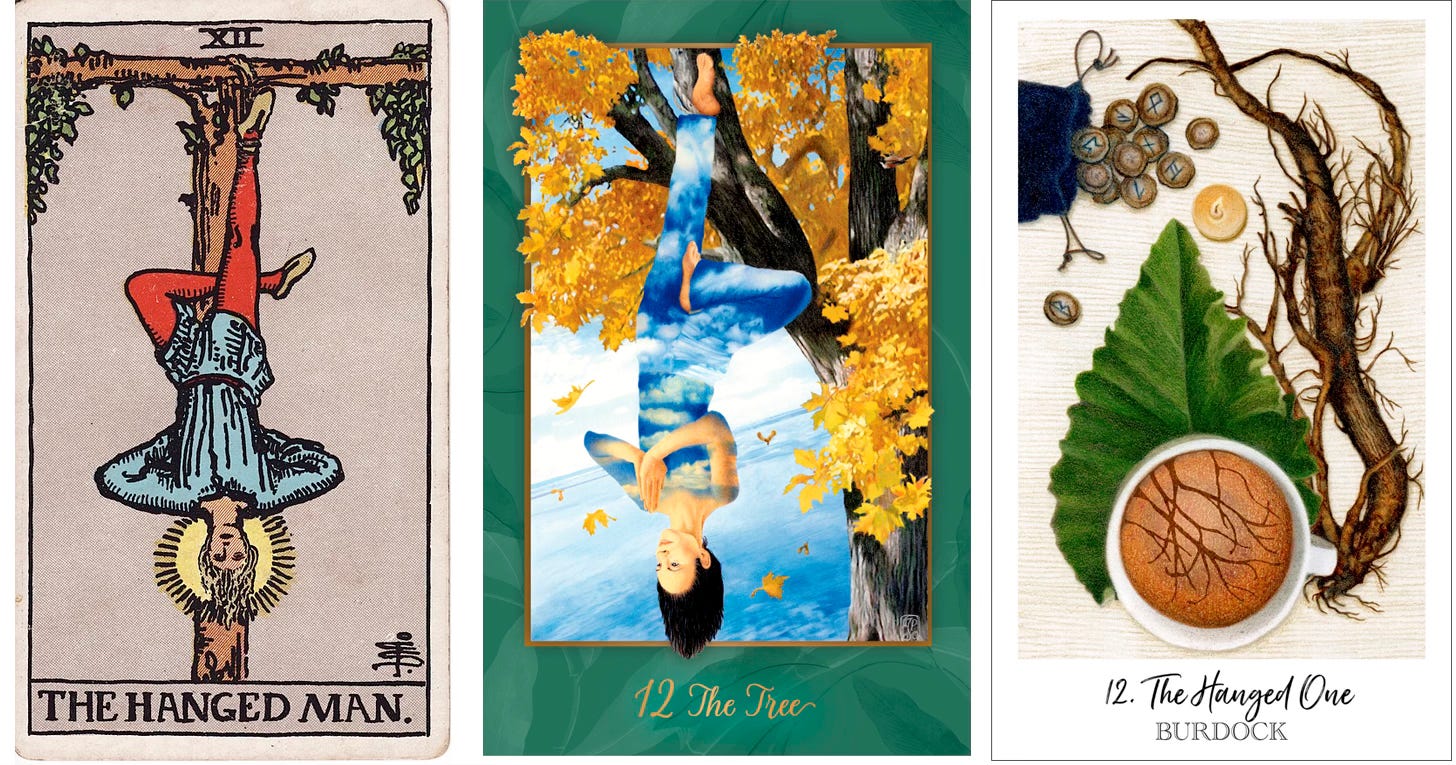Calm, radical acceptance. A change of heart or mind. A sacred pause.
A Journey through the Tarot Major Arcana: the Hanged One ~ Card 12

Dear Ones,
A blessed Lunar Eclipse in Pisces to you!
Thanks for joining me on my quest to renew my tarot practice by taking a journey through the cards of the Major Arcana. This is the thirteenth post in the series, which is an offering for paid subscribers. We focus mainly on the Gaian Tarot and the Herbcrafter’s Tarot in this series, which includes a look at the card’s themes, card comparisons, creative sparks and crafts, journal prompts, and even a playlist inspired by the card. These posts are longer than most of mine. Thanks for reading. I’d love to hear your responses in the comments.
“The Hanged One’s calm suspension suggests radical acceptance despite discomfort. [They are] fully secure in their weirdness. In fact, they prefer to be weird. Unafraid of nontraditional positions, the Hanged One persists toward enlightenment despite adversaries who make fun of them, eschew their mission, or scoff at their intentions. They firmly stand for what matters, even when the wind blows the other way.”
— Maria Minnis, Tarot for the Hard Work: an Archetypal Journey to Confront Racism and Inspire Collective Healing
When I sit down to write these posts on the Major Arcana cards, I ask myself how this archetype or Wisdom Figure is currently showing up in my life. Each card or figure is like a many-faceted jewel, and we often absorb or interact with one particular facet. What about the others?
I first “met” the tarot back in 1970 and began my studies in earnest in the 1980s. I’ve experienced the wisdom of the Hanged One a number of different ways over the decades. “Letting go” is probably my default reading of this card. But I think this is the first time I’ve considered the Hanged One as an outlier, a misfit, an edgewalker—someone who “prefers to be weird,” as tarot author Maria Minnis says in the quote above.
“I see things from a different perspective,” the Hanged One seems to say. “I challenge you to do the same.”
I’m still sitting with this quiet epiphany. Perhaps it’s arising from the work I’m doing with my therapist. Perhaps it’s because of the novel I recently finished, James by Percival Everett, a retelling of the Huckleberry Finn story from the point of view of the enslaved man Jim. (Such a great read.) It occurs to me that I’m doing exactly that with this post and this series—looking at familiar cards in a new way, gleaning new messages and new wisdom.
Here are some of the ways we often interpret the Hanged One in readings. Which ones resonate the most with you?
Letting go.
Surrendering to the Great Mystery, acknowledging that you’re not in control.
Seeing from a new perspective.
A reversal of previously-held beliefs. A change of heart or mind.
Pause and reflect after action, before taking the next step.
Serenity prayer: the wisdom to know the difference.
Seeing things differently from society or people around you. Firm confidence in your own vision.
Spending time with the questions.
Cultivating equanimity. Calm.
Sometimes the Hanged One card feels like a loss of agency, similar to the Tower and Death cards. The Death card usually indicates a slower, more organic change than the sudden trauma of the Tower. The Hanged One too might appear when we’ve experienced a loss, but it’s more about how we respond to that loss. “Let go and let Goddess” we might say. Or: “God grant me the serenity to change the things I can …” Or: “Let’s look at this from a different angle. Let’s take a rest, a pause. Let’s step back.”



